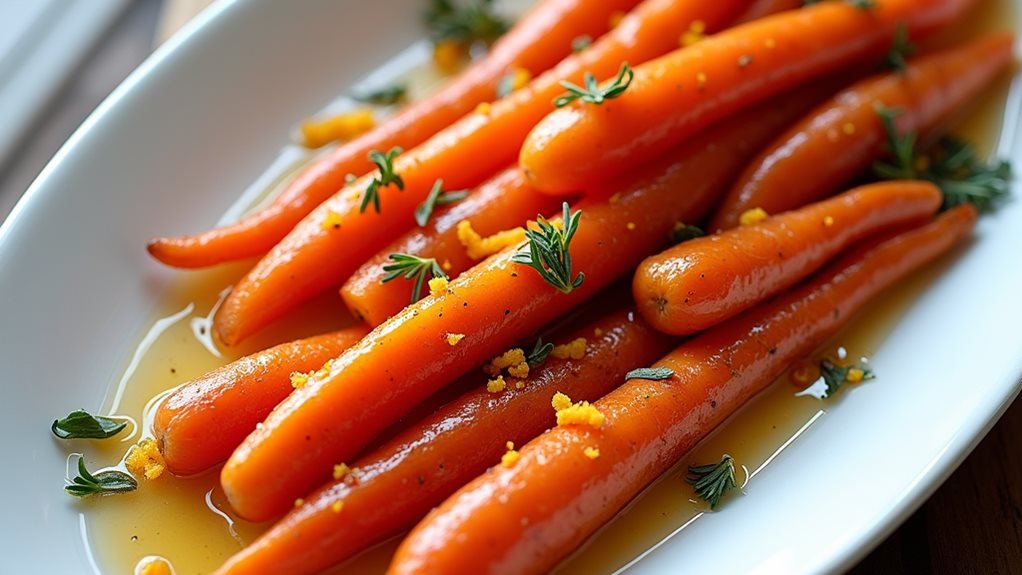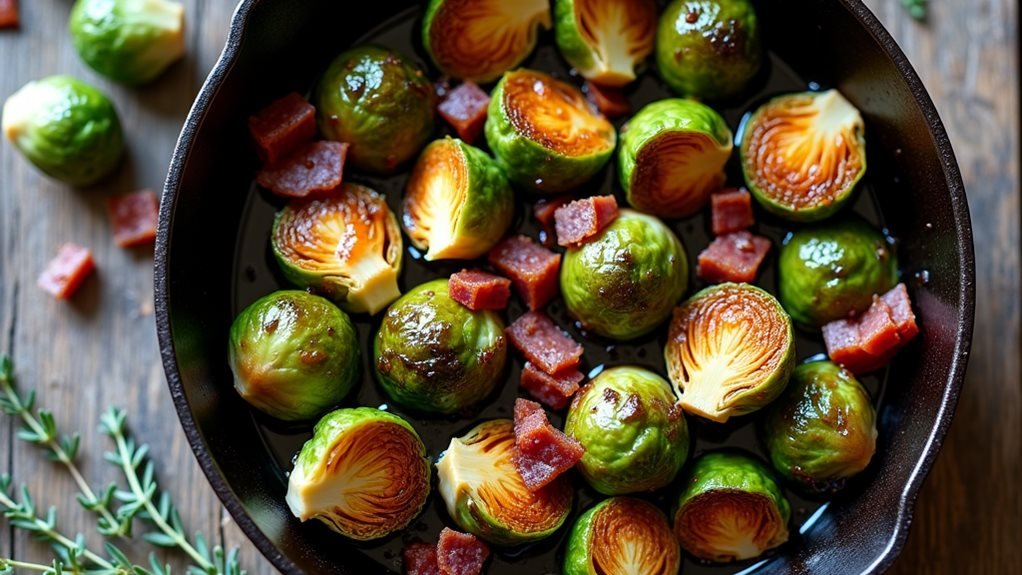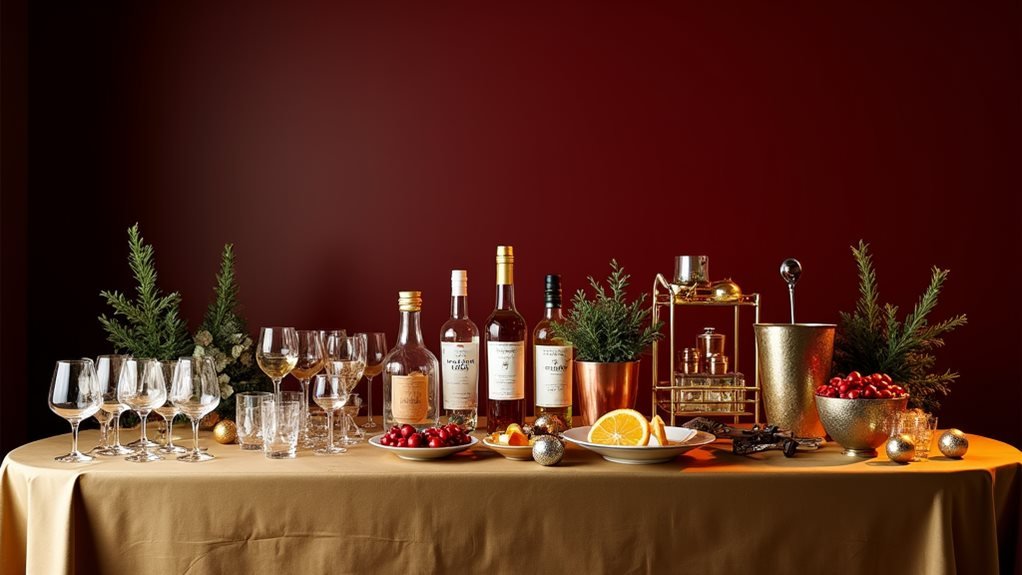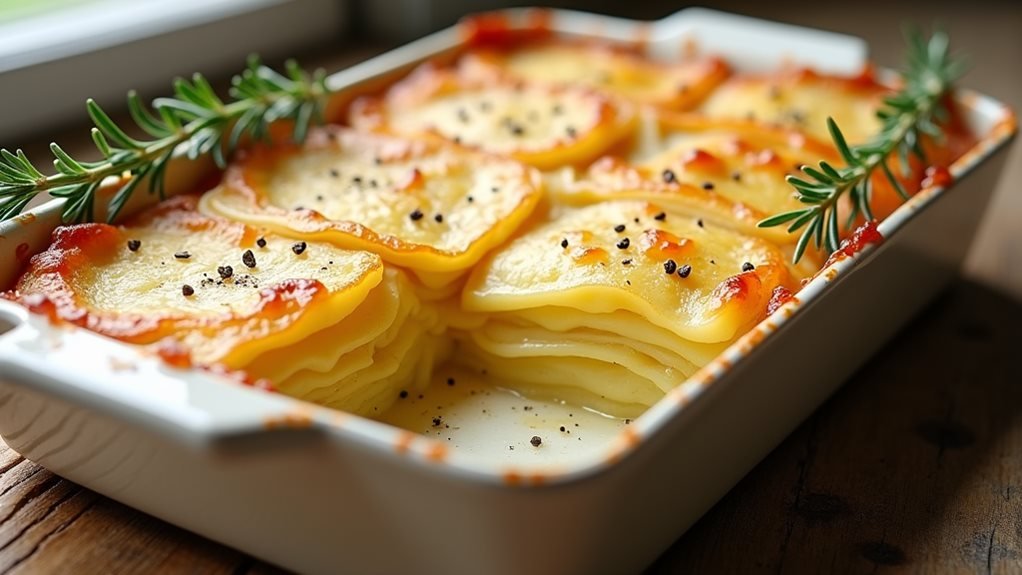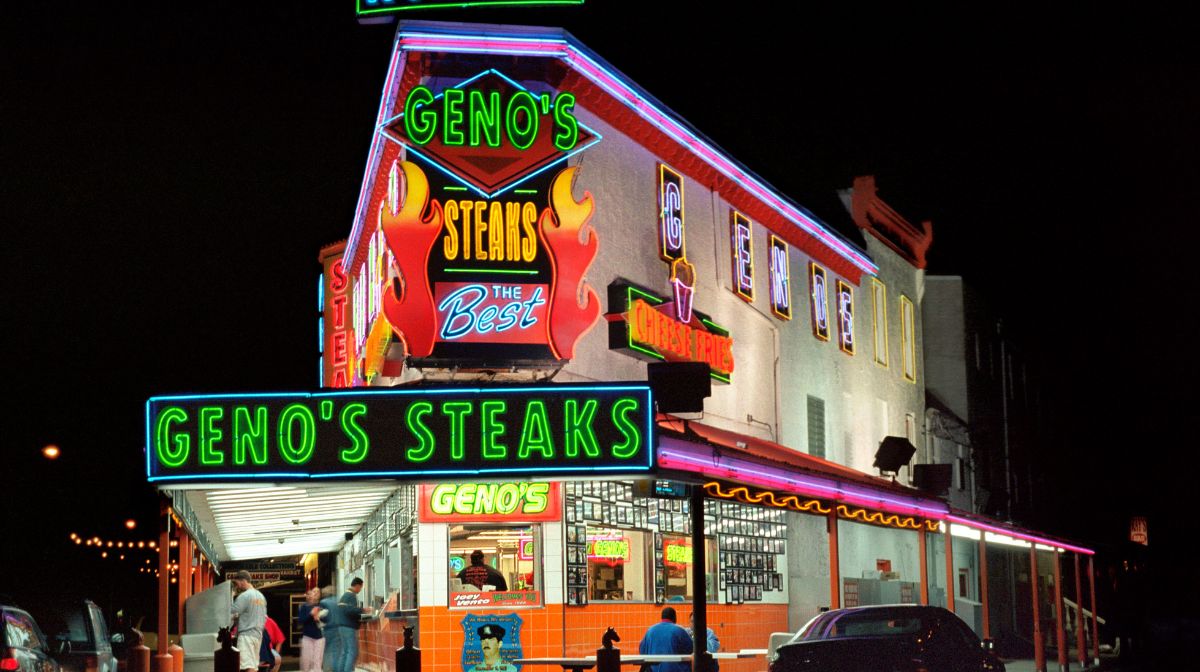Like a painter’s brush transforming a blank canvas, this classic Gordon Ramsay recipe turns humble carrots into a masterpiece of flavor and color. You’ll uncover how the union of sweet honey, fragrant thyme, and vibrant orange zest creates a dish that’s both elegant and comforting. Whether you’re planning a holiday feast or seeking to enhance your weeknight dinner, these honey-glazed carrots offer more than just a simple side dish – they’re proof of how a few quality ingredients and proper techniques can transform the ordinary into the extraordinary. Let’s delve into what makes this recipe a standout in Ramsay’s repertoire.
Recipe Insights
- Cut carrots diagonally into 1½-inch pieces, ensuring even sizes for consistent cooking and professional presentation.
- Combine carrots with butter and water in a sauté pan over medium heat until liquid reduces.
- Add honey and orange zest when the liquid reduces, continuing to cook until carrots develop a golden glaze.
- Garnish with fresh thyme leaves and additional orange zest before serving for visual appeal and aromatic finish.
- Serve immediately in a shallow dish, or keep warm in the oven for up to 30 minutes before serving.
History
Glazed carrots have been a staple of European cuisine since the 17th century when honey and sugar became more widely available to home cooks. This cooking method emerged from the need to preserve vegetables while enhancing their natural sweetness, particularly during winter months when fresh produce was scarce.
In the 18th century, French chefs refined the technique of glazing carrots, introducing butter and herbs to create a more sophisticated dish. Their influence spread across European royal courts, where glazed carrots became a symbol of refined dining.
By the 19th century, the addition of citrus zest had become common as orange trees gained popularity in aristocratic greenhouses.
Today’s version, popularized by chefs like Gordon Ramsay, builds on these historical foundations while incorporating modern cooking sensibilities. You’ll appreciate how the traditional combination of honey and butter has remained largely unchanged, though contemporary chefs often add their twist. The technique has evolved from a preservation method to a celebration of the carrot’s natural sweetness, making it a perfect addition to your holiday table. Much like his approach to sun-dried tomato pesto in his famous tomato soup, Ramsay emphasizes the importance of balancing sweetness with other complex flavors.
Recipe
Honey-glazed carrots are a stunning side dish that transforms basic root vegetables into an exquisite accompaniment for any festive meal. Honey enriches carrots’ natural sweetness, while fresh thyme and orange zest add intricate layers of flavor that perfectly complement traditional mains like roasted turkey or ham.
This recipe strikes the ideal balance between tender and crunchy textures, allowing the carrots to develop a beautiful golden glaze while maintaining their structural integrity. The slow cooking process ensures that the honey caramelizes evenly around each piece, creating a dish that’s both visually captivating and delicious.
- 2 pounds medium carrots
- 3 tablespoons honey
- 2 tablespoons unsalted butter
- 4 sprigs fresh thyme
- 1 large orange
- Water as needed
- Salt to taste
Peel the carrots and cut them diagonally into uniform pieces. Place them in a large sauté pan with butter and add enough water to reach halfway up the sides of the carrots. Bring to a simmer over medium heat and cook for 8-10 minutes until most of the water evaporates. Add honey and orange zest, then continue cooking while stirring occasionally until the carrots are tender and coated with a glossy glaze. Just before serving, strip the thyme leaves from their stems and toss with the carrots.
For best outcomes, select carrots of similar size to ensure uniform cooking times. Avoid overcrowding the pan, as this will cause the carrots to steam rather than develop a proper glaze. If prepared in advance, the carrots can be peeled and cut up to 24 hours ahead and stored in cold water in the refrigerator. Should the glaze begin to darken too quickly, add a small amount of water to prevent burning and allow the carrots to finish cooking properly. These honey-glazed carrots pair exceptionally well with a dry-brined turkey, which delivers perfectly crispy skin and seasoned meat.
Cooking Steps
You’ll want to start by gathering your equipment and prepping the carrots into even diagonal cuts for consistent cooking.
Next, combine the carrots with butter and water in a large sauté pan. Simmer until the liquid reduces before adding the honey and orange zest.
Once the carrots are tender and nicely glazed, you’ll finish the dish by sprinkling fresh thyme leaves over the top, creating a professional-looking side dish that’s ready to serve.
Step 1. Prepare Cooking Equipment
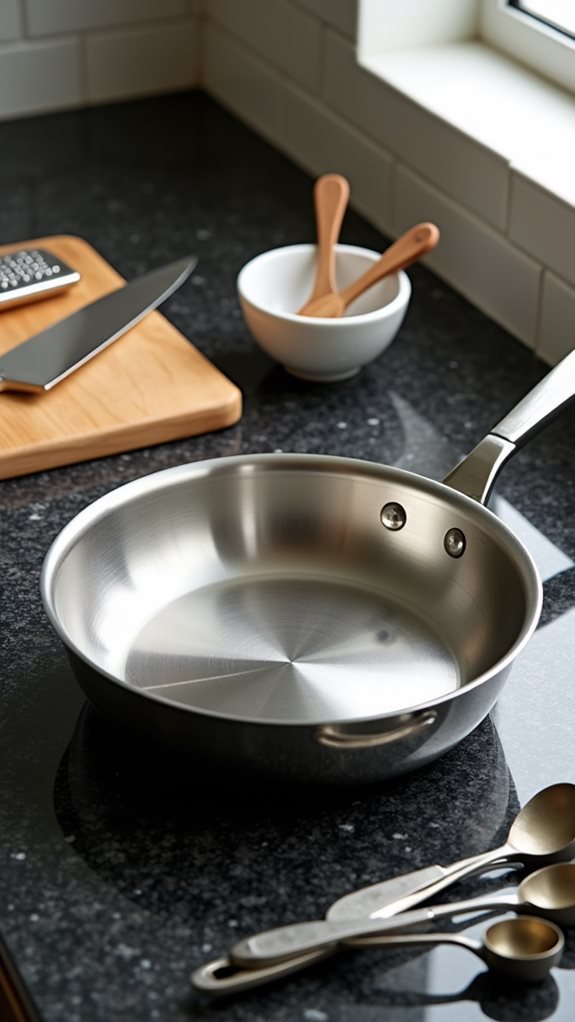
To get started with these honey-glazed carrots, you’ll need a large sauté pan or skillet with a wide bottom and high sides, along with a sharp knife and vegetable peeler. The pan’s size is vital, as it should comfortably accommodate all your carrots in a single layer without overcrowding, allowing them to cook evenly and develop that perfect glaze.
You’ll also want to gather a few necessary tools: measuring spoons for the honey and butter, a microplane or fine grater for the orange zest, and tongs for turning the carrots as they cook. A timer will help you track the cooking process, while a clear lid can be helpful for checking the carrots’ progress without letting heat escape. Keep a small bowl nearby to discard the thyme stems after stripping the leaves.
Before beginning, confirm that our work surface is clean and organized and that all equipment is within reach. Check that your sauté pan is clean and completely dry, as any residual moisture can impact the glazing process. Position it on your largest burner to guarantee even heat distribution throughout the cooking process.
Step 2. Prepare and Cut Vegetables
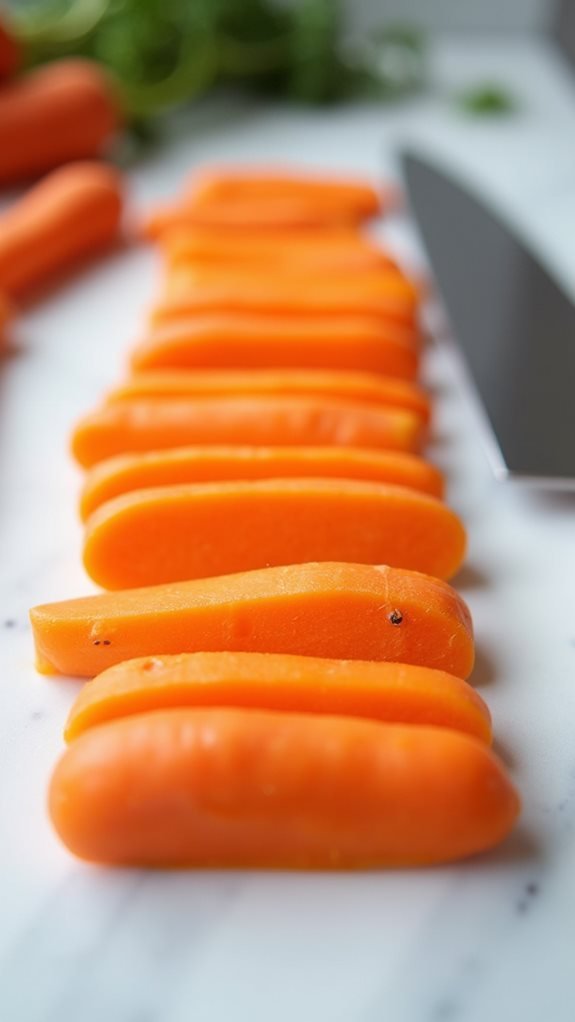
Begin by washing and peeling the carrots under cool running water, making certain to remove any dirt or debris. Using a sharp vegetable peeler, strip away the outer skin in long, steady strokes from top to bottom. To guarantee even cooking times, you’ll want to work with two pounds of medium-sized carrots that are relatively uniform in thickness.
Next, place your peeled carrots on a cutting board and trim off both ends. Cut the carrots diagonally into pieces approximately 1½ inches long, maintaining a 45-degree angle with your knife. This bias cut not only creates an elegant presentation but also increases the surface area that will come in contact with the glaze.
If you’re working with particularly thick carrots, you can slice them lengthwise at the start to create more consistent pieces. For preparation, you can store your cut carrots in cold water in the refrigerator for up to 24 hours – just be certain to drain and pat them dry thoroughly before cooking to achieve the best caramelization when glazing.
Step 3. Add Butter and Water
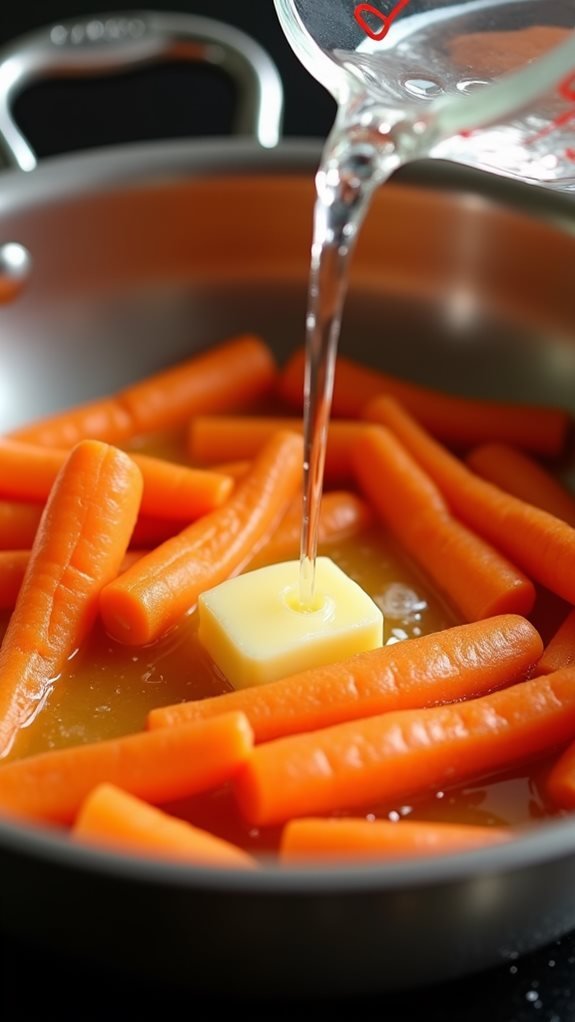
Place the sliced carrots in a large sauté pan with 2 tablespoons of unsalted butter and enough water to reach halfway up the sides of the carrots. You’ll want to confirm the carrots are arranged in a single layer, giving them enough space to cook evenly and develop that perfect glaze. If your pan isn’t large enough, you can cook the carrots in batches rather than overcrowding them.
Set your burner to medium heat and bring the water to a gentle simmer. You’ll notice the butter beginning to melt and combine with the water, creating the foundation for your glaze. Don’t be tempted to add more water than necessary – you’re not boiling the carrots but rather creating an environment where they’ll cook through while the liquid reduces.
As the water simmers, it will slowly evaporate while the carrots begin to soften. This process will take about 8-10 minutes, during which you should resist the urge to stir too frequently.
You’re aiming for the water to reduce naturally, leaving behind just enough moisture to help create your final glaze in the next step.
Step 4. Add Honey and Zest
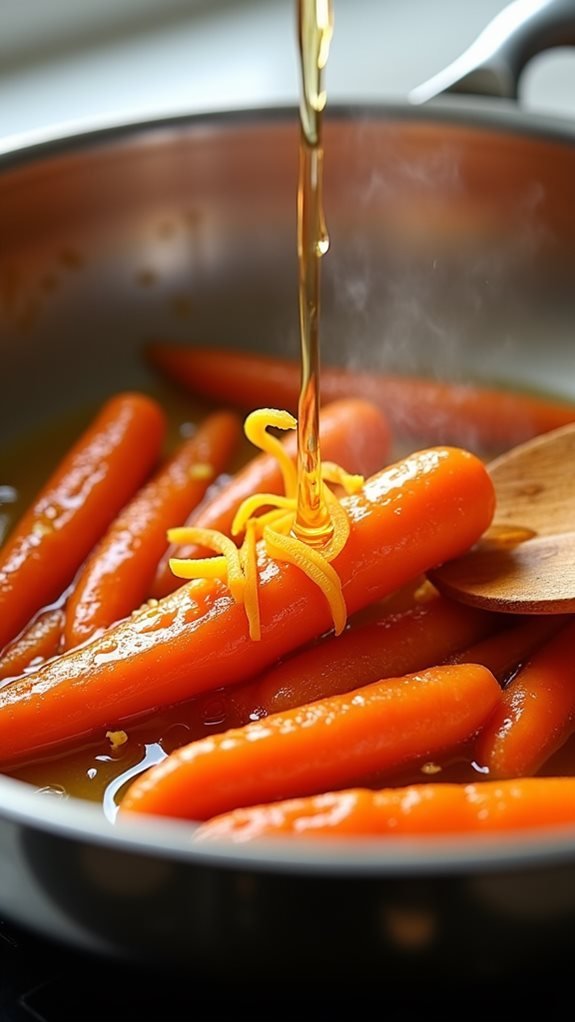
Once the water has nearly evaporated, drizzle 3 tablespoons of honey over the softened carrots and sprinkle the orange zest across the pan. You’ll notice the honey beginning to bubble and combine with the remaining butter, creating the foundation for a glossy glaze that will coat each carrot piece perfectly.
Continue to cook while stirring occasionally, allowing the honey to caramelize and develop a rich amber color. You’ll want to keep a close eye on the temperature, maintaining medium heat to prevent the sugars from burning.
As you stir, the glaze will thicken and cling to the carrots, transforming them into glistening, golden-hued delights.
If you notice the glaze becoming too dark or thick, don’t hesitate to add a tablespoon of water to thin it out. The goal is to achieve a balanced consistency that coats the carrots evenly without becoming sticky.
You’ll know you’ve reached the perfect stage when the carrots are tender-crisp and enrobed in a shimmering glaze that beautifully catches the light.
Step 5. Garnish With Fresh Thyme
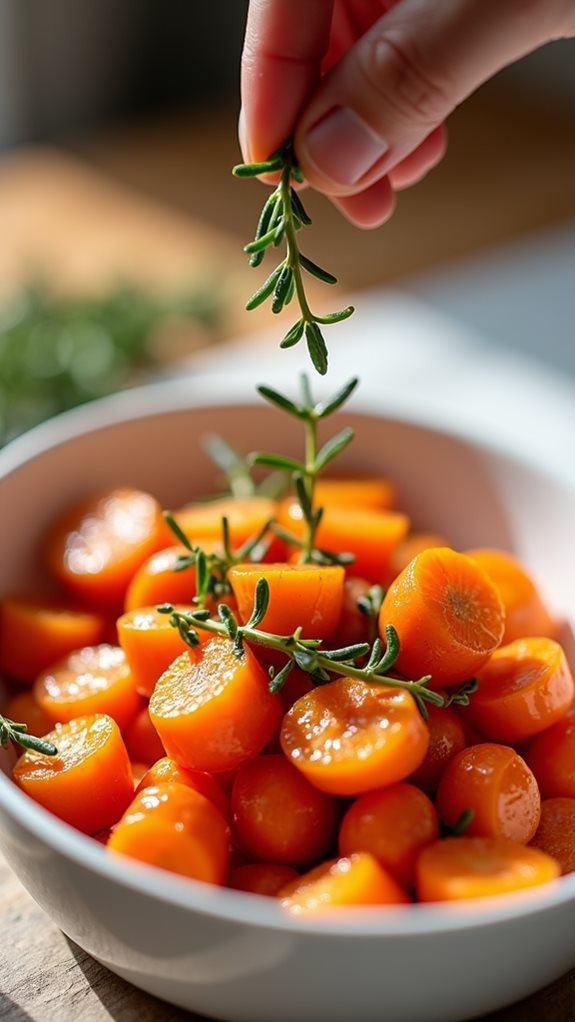
To prepare your beautifully glazed carrots for their final presentation, strip the fresh thyme leaves from their stems and scatter them evenly across the dish.
You’ll want to handle the delicate herbs gently to preserve their aromatic oils, which will release a wonderful fragrance as they meet the warm, honey-glazed carrots. The bright green specks of thyme won’t just add visual appeal; they’ll infuse the dish with an earthy, slightly minty complexity that perfectly complements the sweet glaze.
For maximum impact, you’ll need to work quickly while the carrots are still hot. Hold each thyme sprig at its top and pull downward against the stem’s growth direction—the leaves will easily detach. Don’t worry if some of the smaller stems make it into the mix; they’re entirely edible and can add textural interest.
Give the carrots a final gentle toss to distribute the thyme evenly throughout the dish. This will allow the herbs to slightly wilt and release their vital oils into the glaze. The finishing touch of fresh thyme transforms these honey-glazed carrots from a simple side dish into an elegant accompaniment worthy of your holiday table.
Common Questions About This Recipe
With any popular recipe, home cooks often encounter similar questions about ingredient substitutions and cooking techniques. Dried thyme can replace fresh in a pinch, though you’ll want to use just one teaspoon since dried herbs are more concentrated.
If you don’t have fresh oranges, two teaspoons of orange juice will work, though you’ll miss the aromatic oils from the zest.
Many cooks ask if they can make these carrots ahead of time. While you can prep the carrots 24 hours in advance, the actual cooking is best done just before serving to maintain the perfect glaze and texture.
If you’re working with baby carrots instead of whole ones, reduce the cooking time by 2-3 minutes, as they’re typically more tender.
For those watching their sugar intake, you can substitute the honey with maple syrup or agave nectar. If your carrots are browning too quickly, don’t hesitate to add a tablespoon of water to prevent burning.
Final Thoughts and Serving Ideas
These honey-glazed carrots shine brightest when served in a shallow dish that showcases their glistening exterior. Arrange them in a single layer, allowing the vibrant orange hues and golden glaze to catch the light. For an elegant presentation, consider garnishing with additional fresh thyme sprigs and a light dusting of orange zest just before bringing them to the table.
While they’re perfect alongside a traditional turkey dinner, don’t limit these versatile carrots to just holiday meals. They’ll complement any roasted meat, from Sunday chicken to Easter ham, and they’re substantial enough to serve with vegetarian main courses.
If you’re planning to transport them to a gathering, you can prepare them slightly ahead and reheat them gently with a splash of water to refresh the glaze. For busy hosts, you’ll appreciate that these carrots hold well in a warm oven for up to 30 minutes – cover them loosely with foil to prevent them from drying out. Consider doubling the recipe when serving a crowd, as guests often return for another helping of these irresistible vegetables.
